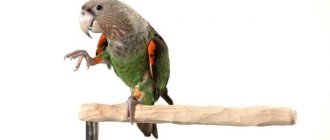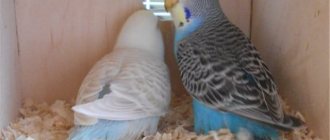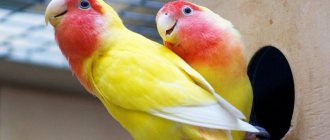In nature, the vast majority of bird species spend most of their time flying, and parrots are no exception. In captivity, they are often kept in narrow cages, and lack of exercise negatively affects their health. An aviary is much better suited for keeping parrots. It is especially recommended for large species; An aviary also becomes necessary when keeping birds in groups. An aviary for parrots can be bought or ordered from a craftsman, but the price for such products is usually high. In this regard, owners often prefer to build homes for their pets themselves.
Pros and cons of an aviary
Parrot aviaries have their advantages and disadvantages. The advantages include:
- large size - birds have free space for flight and active movement; You can place large branches inside or build a play complex;
- the ability to keep a group of small parrots or 1-2 large birds;
- one enclosure is easier to clean than several small cages;
- During the warm season, birds can be kept outside, which has a beneficial effect on their health.
Of the minuses note:
- the need to allocate a large area for installing an aviary - even an aviary for budgerigars takes up a lot of space;
- if one parrot gets sick, it will quickly infect its neighbors;
- fights between birds are possible;
- It is inconvenient to give medications or vitamins to individual birds;
- For breeding, the couple will have to be moved into a separate cage.
What needs to be arranged
There are many options for accessories and toys for parrots to keep them from getting bored in their cage. Which one to choose depends on the type and personality of the birds. Birds, as a rule, like to play and communicate, so owners install bells, swings and mirrors in the cage. It is good to equip an aviary for budgies with a movable wooden ladder on which they love to ride.
The main items that should definitely be in a parrot house are poles, feeders and drinking bowls. It is important that they are made of durable and safe materials and are well secured. It is also useful to provide water baths for birds to bathe.
To simplify cleaning, cat litter is often used in enclosures; it does not harm the birds.
In some cases, an aviary for parrots is a necessity. But it also makes it possible to keep more pets, gives more space and freedom, which makes them healthy and happy. If you want to provide your feathered pets with the most natural conditions possible, an aviary is the best option.
Source
Options for placement of enclosures
Enclosures can be indoor or outdoor. The aviary in the apartment is placed in a well-lit place; if there is not enough natural light, install lamps. Bird housing should be kept away from heating appliances. Do not place it in a draft. An aviary for large parrots is usually placed on the floor. The design for small birds can be installed higher.
The outdoor enclosure is located in a well-lit place protected from the wind. The selected area should not be too wet or cold. The structure must have a canopy from rain and sun. The floor is made so that rodents and predators cannot get inside.
Further stages of creating an aviary
Bird aviary diagram.
If the pipes for support are made of metal, it is advisable to weld the corners to them, then in other cases the installation is carried out using screws. The enclosures are fenced around the perimeter with a net, which is attached to the posts with wire. In the process, so that the tension is sufficient, you can call an assistant who will hold the riot. There are often cases when the mesh is significantly narrower than the height of the intended structure, then each layer is installed slightly overlapping, and so that the edges do not even accidentally separate over time, forming a gap, the cells are intertwined with strong wire. The height of the entrance gate can be different: the entire height of the enclosure or significantly lower. Both options are suitable, only a door that is too high may warp in six months or a year, and if it is low, you will have to cut the Chainlink mesh to install it, and then strengthen it with steel rods.
Having completed the installation of the vertical planes, it’s time to start working on the horizontal plane - the roof. Making a cubic aviary is the best option, but you can diversify the roof by making a superstructure, giving it a pointed appearance and installing a decorative weather vane on top. There are many variations of one design; it is enough to show a certain amount of imagination, not forgetting to take into account the design features of the yard.
The frame is tied on top with a chain link so that its edges go down a little, 20-25 centimeters. The lowered areas are also subsequently stitched with steel wire with a side mesh, creating a kind of monolith. The design will look no less neat if you use clamps instead of wire for tying. The work will go even faster this way, and the strength of the enclosure will not suffer from this.
Scheme of a lifting perch in an enclosure.
Half the process is over when the cladding is finished. What remains is the arrangement of housing for birds from the inside. Each type of bird has its own conditions for proper maintenance, which the owner must already know or study before starting construction of the aviary. The common feature is the presence of a house made of boards, where pets can hide at night, a ladder leading there, perches, and crossbars.
If small predators are rampant in the area, it is advisable to extend the net at the bottom of the enclosure, because when hunting for the tasty morsel, which are birds, a predator can easily make a dig. The “floor” of a stationary structure, which will not move later, can be covered with knocked down boards or linoleum on top of the mesh for ease of cleaning. If this is not done, an unpleasant odor will soon appear near the enclosure.
How to make an aviary for parrots with your own hands
Enclosures offered for sale are not always easy to maintain and do not have the required characteristics; In addition, their price is often high. Therefore, many owners independently build a home for their pet, taking into account its needs and the characteristics of the place where the structure will stand. The construction process may seem complicated, but in fact even a person who does not have such experience can handle it.
Before starting work, determine the location where the structure will be located. Then measurements are taken and a drawing of the future structure is drawn on paper. Based on the drawing, they calculate how much and what materials need to be purchased. The designs of enclosures, as well as the materials used, may vary. The complexity of the work and the cost of the finished product depend on their choice.
Net
The walls and roof of the enclosure are made from mesh. Grids come in the following types:
- made of stainless steel - the safest, but most expensive;
- galvanized - durable, but toxic to birds, so they must be treated with vinegar before installation;
- iron - rust quickly;
- metal in a plastic shell are dangerous, as birds can swallow plastic particles;
- plastic ones are fragile, parrots easily chew them.
Welded gratings with meshes of about 15x15 mm and rods with a diameter of 3-5 mm are best suited for enclosures.
Frame
The mesh is pulled over the frame. It is made from hardwood that parrots cannot chew. Based on the size of the structure, take bars with a thickness of 20x20 or 30x30 mm. The cuts are made even so that no gaps form at the joints. To give smoothness, the wood is treated with sandpaper. The bars are fastened to each other with self-tapping screws and metal corners for furniture. To increase strength, it is recommended to install 1 bar for every 60 cm of mesh. The back wall of the enclosure is made of PVC.
Types of doors
An aviary for parrots is equipped with two doors: a large one, through which the house is cleaned, and a small one, which gives access to the drinking bowl and feeders. A small door is mounted in a large one or installed separately; it is placed closer to the floor.
They make a frame from wooden blocks, which is covered with mesh. An opening is cut out in the wall of the enclosure, along the perimeter of which beams are also secured. Door hinges are attached to them and the door is attached. The latch is placed on the outside in such a way that the parrot cannot open it.
Pallet
The material from which the pallet will be made must be waterproof and also easy to clean. The following materials are usually used:
- plastic – easy to clean and lightweight;
- plywood is short-lived, delaminates when exposed to moisture, but becomes more durable after treatment with hot drying oil;
- galvanized sheet is strong and durable, but has a lot of weight.
For ease of cleaning, the tray is mounted on wheels and handles are attached to it. To prevent debris from accumulating around the enclosure, the tray should have high sides.
Necessary tool
To build an aviary for a parrot with your own hands, you will need the following tools:
- saw;
- drill;
- hammer;
- wire cutters;
- construction stapler;
- screwdriver;
- sandpaper;
- roulette;
- level.
You will also need the following consumables:
- net;
- PVC panel;
- wooden blocks;
- metal corners;
- door hinges;
- latches;
- materials for making a pallet;
- nails;
- self-tapping screws;
- bolts;
- screws.
Video of making an aviary
It is not difficult to build a home for birds yourself. It is important to take the measurements correctly and cut out the parts so that when assembled they form a solid structure without cracks or weak areas through which the parrots can escape to freedom. Detailed instructions for making an enclosure with your own hands are presented in the video:
Features of a street structure
It is designed to accommodate large numbers of parrots outdoors. Its construction does not require significant effort, since it is enough to just make a frame, which is covered with mesh and installed on the foundation.
Base
The foundation helps protect birds from rodents. The process of its creation is divided into stages:
a trench is made, the depth of which is approximately 40 cm;- crushed stones and stones are poured into the pit;
- the trench is filled with concrete;
- a brick wall is made, the height of which is 20 cm;
- the last row is equipped with large vertical bolts on which the corners of the frame and the mesh are attached.
To ensure that the base is strong, an anti-corrosion mesh is used during its formation.
Walls
The dimensions of the open aviary are chosen by the immediate owner, but it is advisable to make it 3 m wide and 2 m high. Such an aviary is convenient to clean, and the birds also get a lot of free space for playing and flying.
2 mesh fences are made, since the outer part protects the parrots from wild birds, and the inner part prevents fights between couples. A distance of 10 cm is left between these fences. The mesh is attached to metal bolts secured by the foundation. All edges are carefully filed down so that there are no sharp corners that could injure the parrots.
Roof and structure arrangement
The roof protects the birds from precipitation and sunlight. It is made from slate or tiles, and it is also possible to use polycarbonate.
As in a regular cage, the enclosure is equipped with perches, toys, drinking bowls and feeders. You can put up small houses where the birds will hide from bad weather. The design is equipped with a reliable lock, otherwise the birds can open the door and get out.
Arrangement of the enclosure
For a comfortable life for birds, the following accessories are placed inside the aviary:
- hardwood perches of varying thicknesses;
- feeders - separate for dry and wet food, wide and stable, ceramic, wooden, plastic or stainless steel;
- drinking bowl - one or several, depending on the number of birds, open or closed;
- bathing suit - a plastic bath with a rough bottom;
- mineral supplements - mineral stone, sepia or a container with coarse sand and fine gravel;
- toys - swings, ladders, ropes, bells, etc.
Foundation
The foundation in the aviary is necessary to protect birds from attacks by small rodents. The algorithm of actions includes the following steps:
- A trench 0.3-0.4 m deep is being prepared.
- The recess is filled with large stones and crushed stone, after which it is filled with concrete.
- A brick wall rises above the ground level to a height of 0.2 m.
- On the final row of brickwork, large bolts are fixed vertically at intervals of 1.5 m along the length. They are intended for further installation of a mesh or corner for the frame.
It is recommended to use a fine mesh with an anti-corrosion coating for an enclosure with a foundation. It is laid before the concrete is poured. The cement surface is covered with earth and sand on top and covered with boards. Recently, bird owners have begun to use linoleum as flooring. This solution greatly simplifies the process of maintaining cleanliness in the enclosure.
When building an outdoor fence for parrots, it is advisable to make the floor sloping. During the disinfection process, the liquid will drain away, leaving a clean surface.
Pheasant pen
Aviaries for pheasants vary depending on the breed of birds and their number:
- Regular pheasants do not require bushes or grass. Free space makes it easier for the breeder to clean the enclosure.
- Ornamental species are not adapted to exist without greenery. In royal pheasants, it stimulates the reproduction process.
- For the normal development of the bird, the area of the enclosure is calculated taking into account 1 m2 per individual.
If you plan to equip a pheasant enclosure with your own hands, it is recommended to consider the following recommendations:
- The pen has a fence not only on the sides, but also on the top. The presence of a roof in the aviary will prevent the bird from flying out. Installing metal products on top is not recommended; give preference to nylon mesh.
- The design should have a door that is convenient for the breeder, so that it is possible to regularly remove eggs forgotten by the female.
- The frame of the enclosure is covered with mesh, but it is better to avoid chain-link. Its weaving can injure the bird. The optimal cell size is 1.5 cm. This design of the bird enclosure will prevent rodents from entering.
- A more compact enclosure for chicks is positioned so that the structure is directed toward the south or southeast. This arrangement of the structure allows you to maximize the period of natural sunlight.
- As in the case of an outdoor aviary for parrots, a pen for pheasants is complemented by a vestibule.
The structure is designed taking into account the penetration of daylight and the presence of artificial lighting in the evening, as well as high-quality ventilation.











